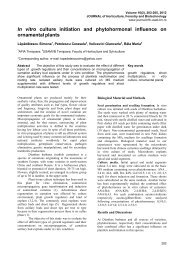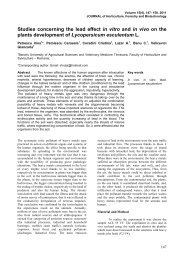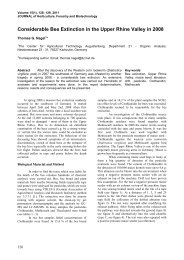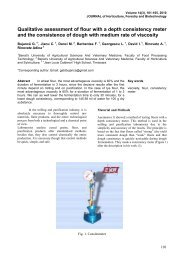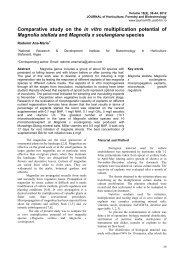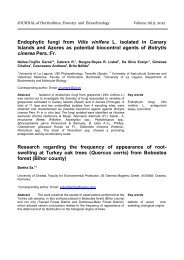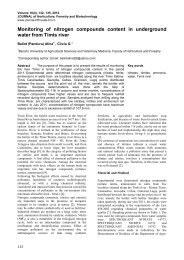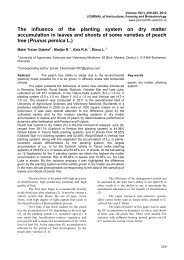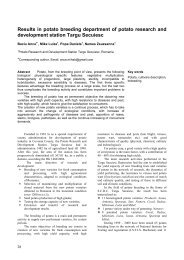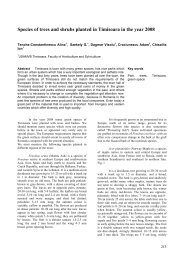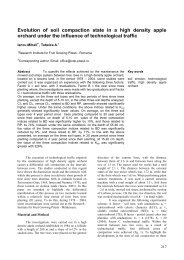measurements of chromosome aberration at tomato plants
measurements of chromosome aberration at tomato plants
measurements of chromosome aberration at tomato plants
You also want an ePaper? Increase the reach of your titles
YUMPU automatically turns print PDFs into web optimized ePapers that Google loves.
D1-D3, while the control registered 0,88%, <strong>at</strong> L27Sgenotype the value were between 0,12-0,24% for D-D3and 0,25% for control.Regarding the percentage <strong>of</strong> cells with an<strong>at</strong>elophaseswith abnormalities the values are higherthan the one registered for metaphases. At genotypeFrancesca, for example, <strong>at</strong> <strong>plants</strong> regener<strong>at</strong>ed from invitro cultures the percentage <strong>of</strong> cells with abnormalitiesin ana-telophases ranged between 1,02-1,35 %, whilethe control registered 1,96%. The same genotype had0,26% from cells in metaphases with abnormalitieswhile the control had only 0,41%.ConclusionsThe results obtained in our experiment provedth<strong>at</strong> in the “in vitro” conditions tested, the types andfrequency <strong>of</strong> chromosomal <strong>aberr<strong>at</strong>ion</strong> are similar withthe control. No other genetic abnormality <strong>of</strong> the tissuecultured<strong>plants</strong> was observed suggesting th<strong>at</strong> geneticfidelity <strong>of</strong> tissue cultured <strong>plants</strong> can be maintained ifappropri<strong>at</strong>e plant growth regul<strong>at</strong>ors are used with lessnumber <strong>of</strong> subcultures in the multiplic<strong>at</strong>ion stage.The cultiv<strong>at</strong>ion <strong>of</strong> tom<strong>at</strong>oes shoot tips onnutritive medium modified with Kinetin and BAPallows the regener<strong>at</strong>ion <strong>of</strong> new <strong>plants</strong> with a stablegenetic m<strong>at</strong>erial th<strong>at</strong> shows little genetic variability.This variability manifested <strong>at</strong> cellular level through thedifferent types <strong>of</strong> chromosomal abnormalities does notexceed the n<strong>at</strong>ural variability present also on <strong>plants</strong>germin<strong>at</strong>ed in “ex vitro” conditions.The main types <strong>of</strong> abnormalities in the rootcells <strong>of</strong> tom<strong>at</strong>oes are ana-telophases with bridges,metaphases with lagging <strong>chromosome</strong>s, expelled<strong>chromosome</strong>s or ring <strong>chromosome</strong>s, multipolar an<strong>at</strong>elophases,as well as binucle<strong>at</strong>e cells and interphaseswith micro-nucleuses.References1. Li M., M. Zhang, 1991 - Technology for plant<strong>chromosome</strong> research. Northwest Forest Univ. Press,Shenyiang, China. p. 31–39.2. Budiman, M.A., L. Mao, T. Wood and R.A.Wing. 2000. A Deep-Coverage Tom<strong>at</strong>o BAC Libraryand Prospects Toward Development <strong>of</strong> an STCFramework for Genome Sequencing. GenomeResearch 10:129-136.3. Mao, L., D. Begum, S.A. G<strong>of</strong>f, R.A. Wing.2001. Sequence and Analysis <strong>of</strong> the Tom<strong>at</strong>oJOINTLESS Locus. Plant Physiology: 126:1331-1340.279



